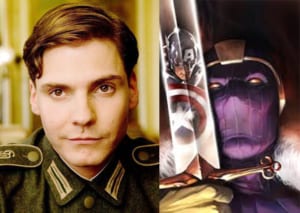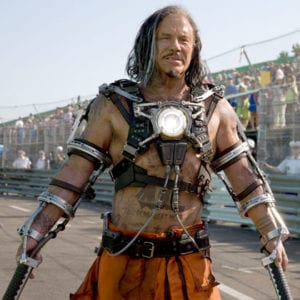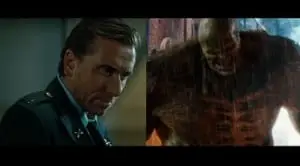Full confession: I heartily enjoyed Marvel’s Captain America: Civil War. The characters were well defined with strong motivations on all sides, and we got several fun and exciting fight scenes. The Accords were the catalyst, and a fascinating one. At the same time, the moral and ethical dilemmas created by the characters’ actions and, the ramifications they faced, were well thought out and balanced. These, in turn, generated compelling questions for the audience to ponder.

Chief of which, for me, is the character and actions of Helmut Zemo. I have seen a lot of reactions to what he did and how exactly he was able to do it. But, I haven’t seen as many people talking about Helmut Zemo as a villain. Specifically, how, like many of the Marvel Cinematic Universe’s (MCU) villains, his emotional ties and connections drive his character and choices. To better understand him, it may be worth beginning by taking a look at the comparable villains in the cinematic MCU.
Darren Cross (Antman, 2015)

Darren Cross was the film’s major antagonist and, later, it’s villain due to the way he treated Hank Pym, Hope Pym, Scott Lang, and his Wombats. However, there is an almost Shakespearean tragedy to his character. He ultimately gained what he wanted (the successful creation of the Yellowjacket suit) and seemingly surpassed his former mentor Hank Pym, but it destroyed him.
Hank Pym understood that the formula for the the Ant-Man suit could drive it’s users insane, which is why he refused to wear it. Well, that as well as his age and the fact that his wife was shrunk down and seemingly lost in the Quantum Realm and his age. Darren Cross had no such qualms about the suit and, unfortunately, did go insane. What’s worse is that he didn’t even realize it. The things he did—from his unending ambition, to murder, to his dealing with Hydra—he did without showing any recognition of why they might be wrong. Nor did he seem to understand the possible ramifications. In the end, there was no possibility for redemption. He died without being saved or even getting a chance to be to be saved.
Ivan Vanko/Whiplash (Iron Man 2, 2010)

Many of Mickey Rourke’s characters’ scenes were cut, making him more of a one dimensional character rather than a fully fleshed, nuanced one. We know he is fueled by hatred and need for revenge (a common theme among Iron Man’s MCU antagonists) against not only Tony Stark but also his father Howard Stark.
The focus solely on his murderous rampage and lack of further character contextual scenes did not serve Vanko as a character. Perhaps if we had been shown more of his background and struggles to round out his character, there may have been more sympathy or understanding. We can only hope that one day Marvel will release the footage that didn’t make the final cut. Nevertheless, Vanko did have legitimate reasons to be angry with the Starks and Iron-Man as a separate entity.Howard Stark built an empire on a foundation that was not solely his own that only benefitted the Stark family while Vanko and his father lived and died in poverty. While Vanko did not achieve all of his goals, his anger and hatred propelled them forward.
Emil Blonsky (The Incredible Hulk, 2008)

Emil Blonsky became the Abomination after being bested by Bruce Banner/the Hulk in a soft drink bottling facility. Having evaded capture, he was given an imperfect version of the Vita Ray Serum (created by Dr. Reinstein for Weapon Plus). Later, Blonsky himself forced Samuel Sterns to inject him with one of the many samples of Bruce Banner’s blood causing him to become the Abomination.
At the time the film was released, Blonsky was a change in MCU villains from being humorous to stark and more serious. He was a well developed and interesting character compared to his villainous predecessors, in that his motivation and his fear went hand in hand: his increased age.
Being a solider, and a good one at that, was Blonsky’s life. At the point we see him in the film, he is too old to continue fighting the way he has been, and the men he serves with are several decades younger than him. Furthermore, he had no chance for an honorable discharge on his horizon any time soon. It was no surprise, then, that he accepted the opportunity from Thaddeus Ross to receive the first of many painful injections and become a bastardization of a Captain America-like super soldier.
The injections did not satisfy Blonsky’s need. As the film continues, we see that they did not sate his bloodlust for revenge against not only the Hulk but also Bruce Banner either, the latter of whom he seemed to hate and envy. Ultimately, Blonsky went too far to become, in his mind, the most “perfect” soldier he could be, sacrificing his body and his mind and giving way to his own cruelty.
With all of these villains and their motivations in mind, we now turn to the man of the hour.
Helmut Zemo (Captain America: Civil War, 2016)
 From the moment we met his character we see a cruel and driven man, but also a broken one. We are never given any flashbacks to Zemo’s life before Civil War, whether his service to his country, its destruction, or his family in the Battle of Sokovia. We do not even know that his wife and child are dead initially, as we hear her voice “alive” on his voicemail. But, it is this voice and this message that act as the emotional trigger and justification for Zemo’s actions.
From the moment we met his character we see a cruel and driven man, but also a broken one. We are never given any flashbacks to Zemo’s life before Civil War, whether his service to his country, its destruction, or his family in the Battle of Sokovia. We do not even know that his wife and child are dead initially, as we hear her voice “alive” on his voicemail. But, it is this voice and this message that act as the emotional trigger and justification for Zemo’s actions.
The standard movie talismans and displays are not shown to the audience to depict his loss, grief, and rage. The presence of such talismans typically allows the character to act on these emotions, to display them. In Zemo’s case, the lack of such talismans fuels his urge to act. The voicemail is literally the only connection Zemo has to his family; there are no toys, no books, no drawings, no charms, no wedding bands, nothing to show he had a family.
With the exception of maybe Loki (who may or may not have been mind controlled by Thanos), Zemo is one of the few villains to actually achieve what he wanted. Yes, he ended up in prison where he is currently facing the threat of prosecution if not execution, he actually won. He set out to turn the Avengers against each other, to get them to fight each other, to hurt each other and maybe even kill each other. And he did.
Zemo was and is a soldier, a Sokovian Intelligence Officer and later a commander of the elite Sokovian paramilitary unit called EKO Scorpion. He knew from studying the Avengers and the villains who preceded him that we would never win by taking on the Avengers head on. He didn’t have the resources to do so. But, he did have the tools to study them, to learn their secrets and successfully make the Avengers fight each other rather than him. This is thanks in large part to the intelligence collected throughout the years from HYDRA infiltrating SHIELD and disseminated by Natasha Romonova in Captain America: The Winter Soldier. He achieved all of this without an army, without magic, without any serum or super powers, and even without a large amount of money, weapons, and resources.
His plan has been dissected, criticized, and reworked by fans. Some call it some plot shield, as I did at first glance. What intrigues me about Zemo’s plan is, unlike other MCU villains’ plans, his displays a striking simplicity. It lacked extensive depth, backup plans, and subplots. Ff he couldn’t get A, then he would try B, then C, and so on using interrogation, torture, and other machinations. For example, when the HYDRA leader of the WSP Winter Soldier Program Vasily Karpov refused to answer Zemo’s questions about the Starks’ assassination, Zemo used the Winter Soldier manual. He studies what may have been done to the Winter Soldiers, learns the code words used to control them, and then get the information straight from the horse’s mouth: James “Bucky” Barnes. Once Zemo achieves this goal, the rest of his plan falls together.
I find myself respecting the character, despite him being a villain. He managed to do what even Loki, a god, seemingly could not. He defeated the Avengers. More than that, he did it for the most part entirely on his own and without having to physically fight them. It’s impressive, even more so when you see how frequently the other villains have failed to even their goals.
Yet, despite his truly remarkable achievement, his ‘victory’ over the Avengers has a hollowness to it. By the time the credits roll, Zemo has won, but in so doing, he sacrificed his humanity and gave himself wholly over to his cause and to vengeance. The film, and his arc, ends with the deletion of his wife’s voicemail. Bereft of connection to his family and his past, his conversation with T’Challa felt like a long, bleak suicide note. He’s a lesson in the cost of single-minded revenge; by dehumanizing the Avengers, he dehumanized himself.
Only time will tell whether Helmut Zemo succeeded in destroying the Avengers in the long run or not, and what happens to him now is still left to be seen. Nevertheless, I enjoyed his character and what he stood for in the movie. He designed a deceptively simple plan to take down the Avengers and succeeded, which is rare for an MCU villain. At the same time, he is fundamentally a flawed and broken man and the story never excuses his behavior. There’s no getting around the fact that he’s a horrible person, but he’s also a compelling character as a villain. I decry his actions, but appreciate his role in Civil War and look forward to seeing more of him in future MCU films.

